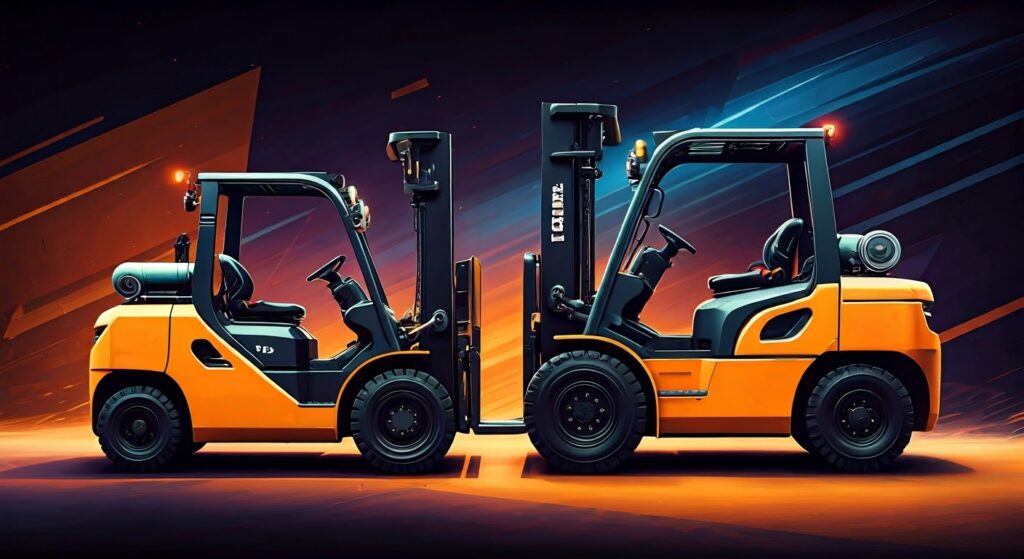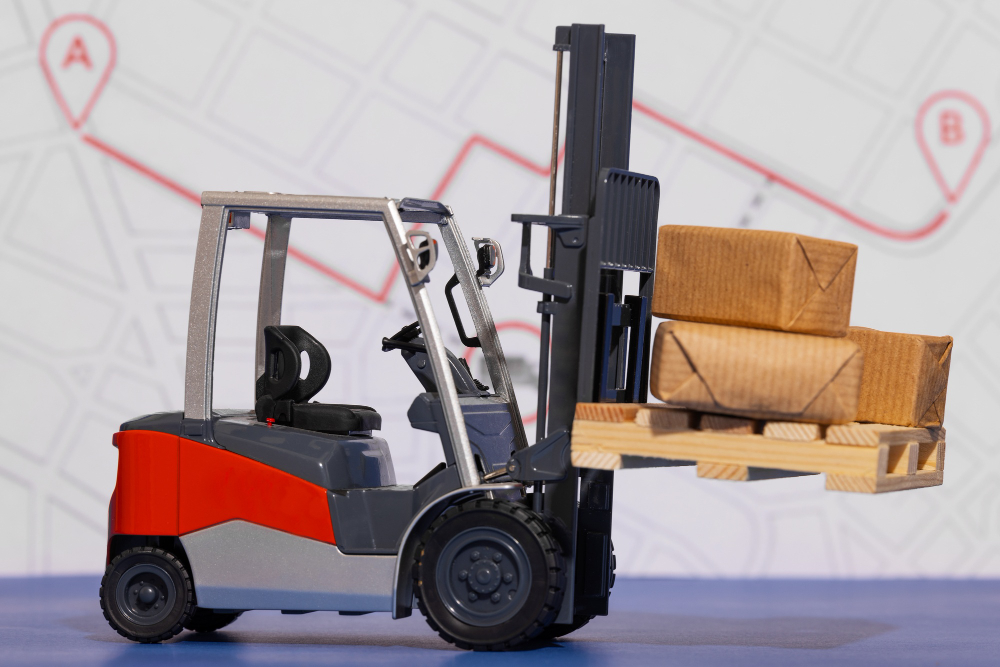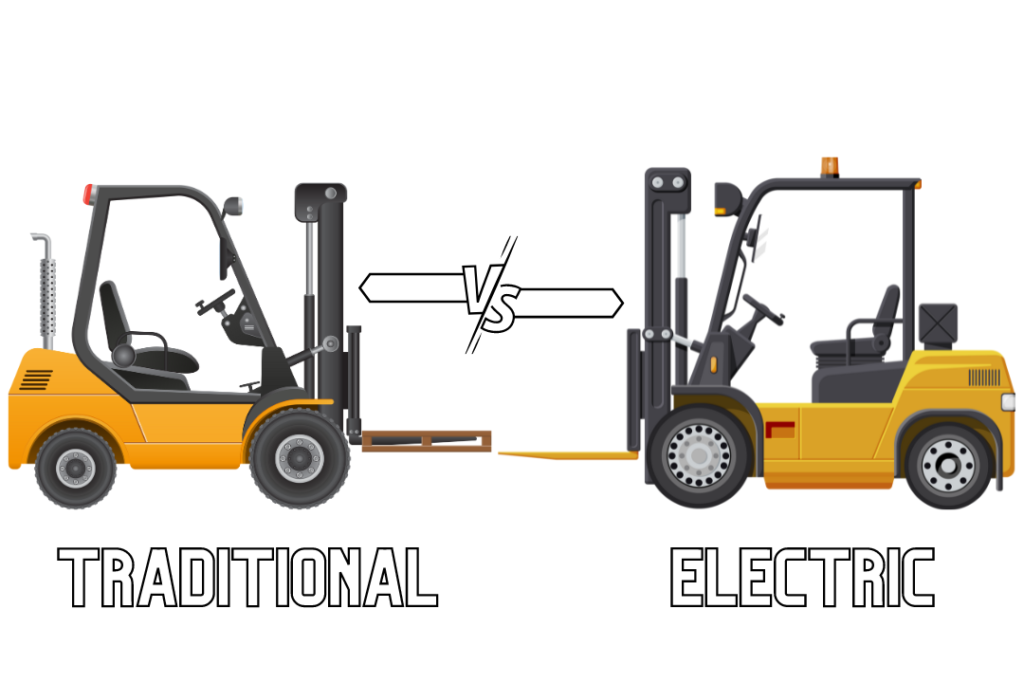Electric and Diesel Forklifts [ROI Analysis]
Considering a smart choice for investing in your material handling equipment? The choice between electric and diesel forklifts can significantly impact your bottom line, operational efficiency, and environmental footprint.
Electric forklifts involve zero gas, have lower operating costs, and are quieter than gas, making them a more suitable option for indoor use and the ones with high environmental consciousness. Conversely, diesel forklifts are designed for heavy-duty outdoor applications and they are more powerful and offer immediate refueling. The below points are covered in this detailed guide:
- Complete cost analysis including initial investment and long-term ROI
- Performance comparison in different working environments
- Environmental impact and regulatory compliance
- Maintenance requirements and operational costs
- Future-proofing your fleet against upcoming regulations
If you decide to increase your fleet or replace old equipment, then this thorough analysis will definitely assist you to make the right choice, which will match your operational needs and budget limits.
Key Takeaways:
- Electric forklifts excel in indoor warehouse operations, offering lower operating costs and zero emissions, making them ideal for tight spaces and environmentally conscious businesses.
- Diesel forklifts are the most popular option for heavy-duty transportation and outdoor activities that require movement over rough ground and dealing with heavy loads, particularly batteries.
- The expense for running an electric forklift is quite different electric forklifts at first, cost more, but in the following years, their running expenses are less than diesel forklifts. In contrast, diesel forklifts, which are a lower upfront costs, have higher fuel and maintenance costs.
- Among the top considerations of the electric forklifts is the environment one of their selling points is that electric forklifts are environmentally friendly and make no noise, also they complete the process faster than other forklifts. However, diesel motors contribute to air pollution with the emissions of carbon dioxide.
- The main technical demand is the huge difference among these electric forklifts, the battery maintenance (lead-acid or li-ion) but the benefit of moving fewer parts, versus diesel forklifts the regular demand for the engine and hydraulic oil(mac) changes.
Operational Cost Breakdown
Fuel and Energy Expenses
The fuel cost and energy cost are primary factors as they may significantly affect the overall operational charges when comparing electric and diesel forklifts. Electric forklifts are generally less energy-costly as electricity is quite cheaper than diesel fuel. The power to charge an electric-powered forklift costs around $3-5 per day, in comparison to diesel-powered forklifts that can use 3-4 gallons of fuel daily, thus, to spend $12-15 on fuel.
Besides, electric forklifts are advantaged by the fact that electricity rates are usually more predictable in terms of price and thus change less frequently than diesel fuel prices, providing a more stable energy-cost scenario. This regular rise in costs is helpful in calculating the vocational charges of the company.
Maintenance Requirements
In the case of electric and diesel forklifts, production is daunting. There is a significantly higher cost for routine maintenance for diesel forklifts than for electric ones. Diesel forklifts are equipped with more complex engine systems, so they demand more frequent regular maintenance. Thus, they require oil changes, filter replacements, and hydraulic oil change services every 200-300 operating hours.
Electric forklifts are simpler in design and therefore require very little maintenance since they have less moving parts. They get the main part of battery care and electrical system checks. Even though the first battery cost might be more, lower costs in the long run are common because of the lower frequency of maintenance.
Here’s a listing of their standard maintenance requirements:
Electric Forklifts:
- Battery watering (if the battery is lead-acid)
- Terminal cleaning
- Yearly electrical system inspection
- Brake system check
Diesel Forklifts:
-
- Engine oil changes
- Fuel filter replacement
- Air filter cleaning
- Regular cooling system maintenance
- Transmission service
The regular maintenance costs for diesel forklifts usually range from $4,000 to $6,000 per year, while electric forklifts cost around $1,500 to $3,000. The difference in maintenance costs is significant and can influence your bottom line over the longevity of the equipment.
💡 Key Takeaway: Electric forklifts dramatically decrease energy usage and maintenance with a simplified system, thus lowering operational costs, while diesel forklifts waste money on fuel and are high maintenance items.
Performance and Capability Analysis
Load Handling Capabilities
A fundamental component under consideration in the selection of forklift moving loads is the handling capacity. Diesel forklifts have been known for their handling of heavy load requirements, which is mostly in outdoor places and on uneven terrains. By possessing robust engines, they render alike power that is stable which suits such operations as lifting as intensively as may be required.
Electric forklifts used to be considered as low capacity lifts, but they have developed technologically to the point where they can handle even heavier loads. Nowadays, electric models can easily lift heavy weights, still they might have deficient performance in very demanding applications. Their steady output, which they gain from the torque delivery, in fact increases the chances for lower damage to loads but nevertheless ensures safer operations.
Maneuverability and Space Requirements
Electric forklifts are the best option if you have to work in small space situations. Their small size and precision in the control systems of forklifts make it easy for the operator to be able to move through tight spaces without any problem. These are further useful in warehouses since it is vital that space should not be wasted.
The edges of the diesel forklifts in the area of working in small spaces become rather blurry. A higher turning radius is required for the operation of the diesel forklift, which makes it take up more space to operate. Still, they have far greater stability than when working in such conditions. Their solid build-up promises a key guarantee that they will work steadily even if the conditions of the surfaces are not the best.
Both types of forklifts possess certain advantages that depend on your operating environment. Electric models are especially good for working indoors with limited space, while the diesel options are more versatile and are better on different terrains and in bad weather conditions.
💡 Key Takeaway: Electric forklifts are the best choice for better maneuverability in tight spaces, whereas diesel models are the number one in heavy load handling and rough terrain operation, making it an environmentand time-specific option.
Application-Specific Considerations
Indoor Operations
Electric forklifts are the best and most convenient option for use in warehouses, especially in case of limited space. The zero-emission characteristic of the forklifts creates a healthier working environment, with fewer pollutant emissions. Such an improvement is particularly notable in confined areas where the air is of high importance. Another benefit of the quiet operation of electric forklifts is a better working environment, unlike the noisy environment where workers can be less productive and communicate worse because of the high noise level.
Electric forklifts are superb in terms of exactness and flexibility in the behavior; thus they are well-suited for electrified warehouses where narrow-aisle passages and confined storage arrangements predominate. The smooth acceleration and responsive controls of the units such as electric forklifts give the go-ahead for operators to work with greater precision and less damage to the products and racking systems.
Outdoor and Heavy-Duty Applications
Typically, diesel forklifts show the best results for outdoor operations and demanding tasks, which are their main points of strength. Their formidable power output and the capability to climb steep gradients are the main reasons for the latter. Therefore, they are especially adapted to rough terrains and unfavorable weather conditions. Moreover, diesel forklifts are surprisingly effective in applications that require continuous operation without downtime for battery charging.
Nevertheless, the use of the modern electric forklift is continuing to expand its application area to the open-air regions with weather-resistant components and advancements in battery technology. The point is to properly determine the characteristic features your forklift will have to possess to operate at your workplace. Diesel forklifts, despite their significantly improved performance and reliability, are still the top choice in the heavy-duty setting while emerging electric forklifts have gained grounds to bridge the performance gap.
💡 Key Takeaway: The most sensible decision is for electric forklifts in the warehouse that requires little noise and air pollution, while the diesel lifters are proper under rain and for heavy-duty activities although electric technology is advancing.
Conclusion
The choice of electric or diesel forklift will probably be one of the most important and strategic matters that would demand a thorough analysis and evaluation related to your company’s needs, objectives, and financial center. The comparison of the total cost of ownership, the technical effectiveness, and the ecologic influence will help a person make a proper choice that will be a perfect fit for the internal combustion forklift. Also, be aware of the fact that electric forklifts are ideal for indoor work areas
because they have low emissions and lower operating expenses, but diesel forklifts are still the best solution for heavy-duty outdoor applications and poor ground maneuverability. Some of the things you may want to think about are your working conditions, type of maintenance and the present and future legalities that you have to follow. Do you want to revolutionize your materials handling operations? Call our forklift specialists right now for your individual discussion and a detailed ROI analysis that fits for your business. Our broad selection of both electric and diesel forklifts will surely cater to your needs and become the sustainability you are aiming to experience.
FAQs
How much longer on average can electric forklifts last as compared to the diesel forklifts?
According to the fact sheet, the best electric forklifts with additional time together count and use a reliable battery to keep you going for the entire shift as long as 6-7.5 hours, whereas diesel trucks operate approximately 5-6 hours which under extreme conditions may be shortened to 4-5 hours. The least likely electric trucks have the most moving parts, wind up the most and need the most care thus bringing the durability down because of the smallest number of running ones and the least mechanical pulling, which in effect prolongs its life likewise.
What are the hazardous effects of extreme weather on the electric forklifts compared to the diesel ones?
Usually, it is the engine machines that are more productive under hot/cold/pouring rain conditions respectively than the battery ones. Extreme cold might have the most severe effect when batteries start to weaken the least energy through them which cannot be enough thus lowering the performances of the electric at the same time. Therefore, battery forklift is always the best solution due to its better performance in winter which is always compatible with modern li-ion batteries because reveals their notable enhancements in term of cold-weather better functioning.
Can I upgrade my current forklift from diesel to electric motor?
The procedure, in reality, is feasible but most of the time it is not the economical option. The conversion of a diesel machine to an electric one involves carrying out substantial changes to the power train, the hydraulic systems, and the overall structure. The better is to buy a battery-charged electrically-powered forklift that has been designed for this purpose and you don’t have to bother anymore with fuel and oil and the related costs.
Which differences in operator training do you expect will occur?
Every kind requires particular training for operators. While diesel forklift training stresses engine maintenance and fuel handling, electric forklift training concentrates on battery management and charging processes. Though both need appropriate certification, electric forklifts usually have a shorter learning curve.
What comparisons can be drawn between the time charging and time refueling schedules aside from operational efficiency?
Diesel lift trucks can be filled with diesel oil through a process that takes 5 to 10 minutes and can be used for 8-10 hours. Electric forklifts, for their part, need a window of 6-8 hours for full charging but can operate an entire shift. So that the electric forklifts can be used in the high-intensity operations with the least possible downtime, both rapid-charging and battery replacement systems are available to minimize charging time and keep the forklift in operation.
Could you list out the differences in insurance cost figures for electric and diesel forklifts?
Insurance price reduction is one of the great things that electric forklifts have. Aside from the decreased fire hazards, the cleaning needs for employees will be less, resulting in lower insurance prices. A direct comparison of diesel forklifts that have higher insurance premiums with electric models reveals that the former is even more prone to hazards and demanded more complex mechanisms that can be the reason for malfunctions.



